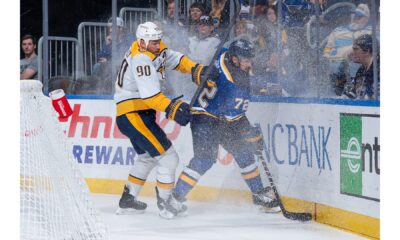UPDATE: In the original version of this article, I decided to include model results generated using data from the beginning of February. My reasoning was that some teams change dramatically over the course of the season, especially compared between pre- and post-trade deadline.
In favor of improving the sample size of my analysis, I decided to run the model again, this time including data from all 82 games of the regular season. Many of the results are quite different. All in all, I think this version provides a more accurate look at how I expect the first round of the playoffs to end up.
(Original article below)
Nashville fans breathed a sigh of relief as the regular season concluded. Rather than playing St. Louis or Winnipeg in the first round of the playoffs, the Predators used a late surge to win the Central Division, and were rewarded with a matchup against the Dallas Stars.
The regular season win/loss column suggests Nashville is the favorite in the series. That said, the Central Division was by far the closest race to reach this year’s postseason. Nashville won just four more of their 82 games than Dallas, so the seeding isn’t the best predictor in how these games will shape out.
Taking a deeper look into how each team has performed over the past couple months provides a better understanding of these two opponents.
In my first attempt, I decided to only include data from the beginning of February, just after the All Star break. Many teams look quite a bit different than they did in October, or, like Nashville, have been dealing with long-term injuries to key players throughout the season. It was tempting to only use games after the trade deadline, but I ultimately decided the sample size was not sufficient.
The math
I won’t get terribly detailed with the composition of the model, but I do want to explain its basic approach. Based on what we know about which teams are generally successful in the NHL, I wanted expected performance to be a function of the number of scoring chances generated, as well as the quality of those chances. Simply put – a team that produces a lot of high-quality chances is expected to win more games than a team that produces fewer of them.
Goaltending is also supremely important in the playoffs. It’s not uncommon for a mediocre team to find themselves on a deep run solely because of high-quality goaltending. I included each team’s save percentage broken down by the quality of the chances faced.
Because each team has played about 30 games since the beginning of February, there is a fair amount of variation. It’s okay to use averages for most analysis, but I wanted this model to account for that variation. To do so, I used quartiles to find a reliable range in values.
All of that might seem complicated, but it’s easier to visualize. Since February 1st, here’s how Nashville and Dallas have been producing in terms of high-danger shots on goal (raw data from naturalstattrick.com).
You can see that, on average, Dallas has produced more high-danger shots on goal per 60 in the selected timeframe. There are a handful of extreme values, especially for Nashville. This model would include the range of values inside each box. Any value above or below the boxes was omitted.
These exact values (among many others) were actually incorporated into the model, so it gives you a nice look under the hood at how some of these probabilities were generated.
While many view the extra home game as valuable in the postseason, its actual effect on each team’s performance is relatively marginal. Still, I did include a slight adjustment based on the expected impact of home ice advantage over a best-of-seven series.
The matchup
As you saw above, Dallas produced more high-danger shots on goal than Nashville over the past couple months. Those shots provide the highest chance of a goal being scored, so it’s a worrying trend for Nashville fans.
The Predators, of course, have enjoyed elite goaltending throughout the season. Compared to other playoff teams, this trend is reflected in their high-danger save percentage. Unfortunately, while Nashville is saving about 1.5% more of those shots, Dallas’ high-danger save percentage has been nearly 6% higher than the average playoff team since February 1st. This is a clear advantage over the Predators in this series.
Interestingly, in terms of goaltending against lower quality shots, Nashville has been considerably worse than average for a playoff team. For Dallas, the results are more of a mixed bag. In spite of the general belief that Nashville has some of the best goaltending in the league, this category seems to provide Dallas yet another advantage over the Predators.
The results
I might invest in witness protection before sharing this on a Predators-heavy blog, but my model does not favor Nashville in this matchup. In fact, Dallas is a strong favorite to advance to round two.
In case you’re curious, here are my predictions for each of the first round matchups, Nashville’s included:
Winning game one is critical for the Predators. As the underdog, Dallas will get a huge boost if they’re able to grab an early road win. If Nashville can put the hammer down from the start, the Stars will face a much harder battle.
















